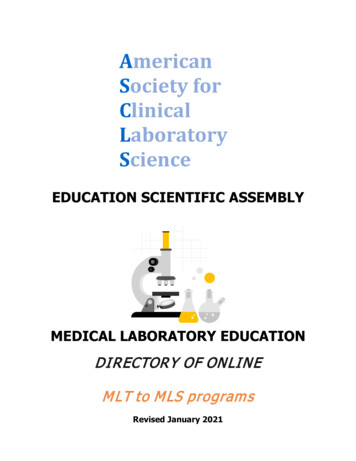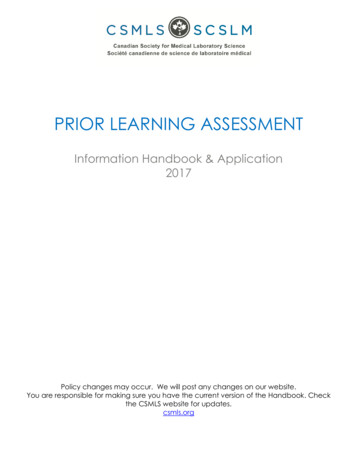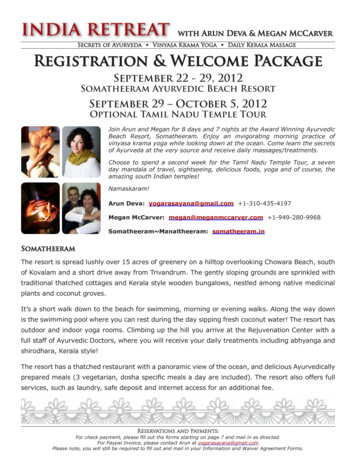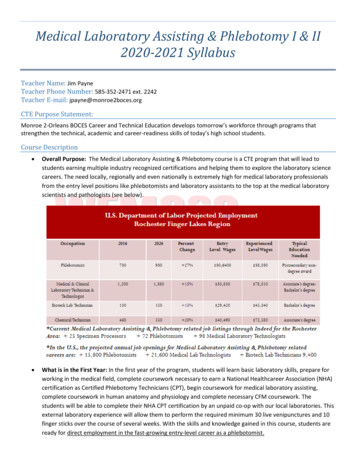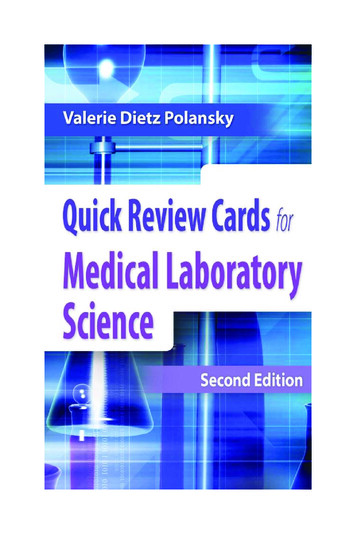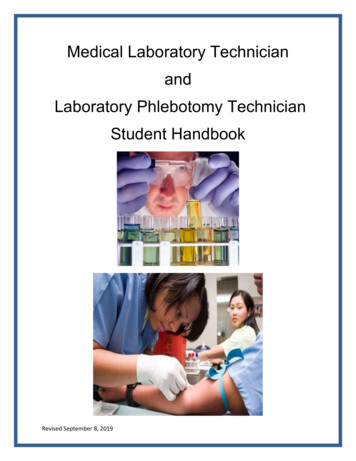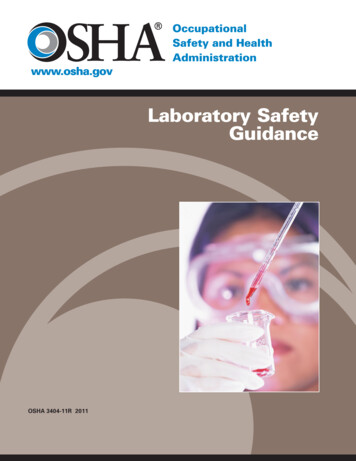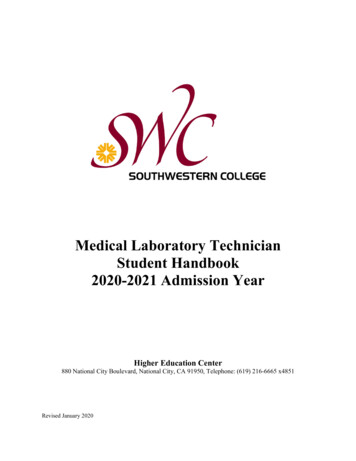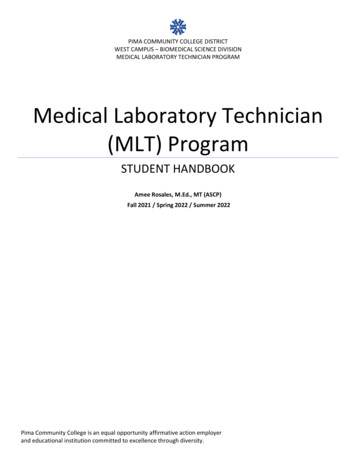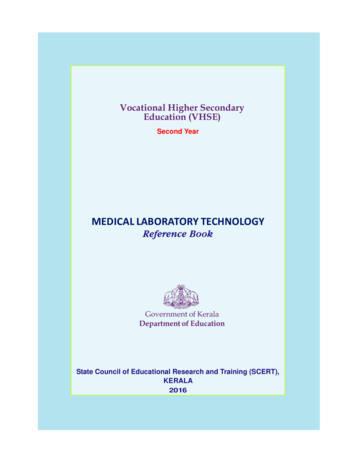
Transcription
Vocational Higher SecondaryEducation (VHSE)Second YearMEDICAL LABORATORY TECHNOLOGYReference BookGovernment of KeralaDepartment of EducationState Council of Educational Research and Training (SCERT),KERALA2016
Reference BookList of ContributorsParticipants1.Dileep R.K2.Sanjeev Kumar P3.Sabeerali kundukavil4.Shyju V S5.Abdullakuty K6.Jahfar PVocational Teacher in MLT, Victory VHSS al Teacher in MLT, GVHSS Arimbra, MalappuramVocational Teacher in MLT, GVHSS Omanoor, MalappuramVocational Teacher in MLT, GVHSS Kondotty, MalappuramVocational Teacher in MLT, BYK VHSS, Valavannur, MalappuramVocational Instructor in MLT, Calicut Girls VHSS, KozhikkodeExperts1.Dr. Pradeepkumar M2.Gopakumar TAsst. Prof. in Biochemistry, Medical College, ThiruvananthapuramAsst. Prof. in Microbiology, Medical College, ThiruvananthapuramAcademic Co-ordinatorSmt. Bindu CResearch Officer, SCERTPrepared by :State Council of Educational Research and Training (SCERT)Poojappura, Thiruvananthapuram 695012, KeralaWebsite : www.scertkerala.gov.in e-mail : scertkerala@gmail.comPhone : 0471 - 2341883, Fax : 0471 - 2341869Typesetting and Layout : SCERT Department of Education, Government of Kerala2
Medical Laboratory TechnologyFOREWORDDear Learners,This book is intended to serve as a ready reference for learners of vocationalhigher secondary schools. It offers suggested guidelines for the transaction of theconcepts highlighted in the course content. It is expected that the learners achievesignificant learning outcomes at the end of the course as envisaged in the curriculumif it is followed properly.In the context of the Right- based approach, quality education has to be ensuredfor all learners. The learner community of Vocational Higher Secondary Educationin Kerala should be empowered by providing them with the best education thatstrengthens their competences to become innovative entrepreneurs who contributeto the knowledge society. The change of course names, modular approach adoptedfor the organisation of course content, work-based pedagogy and the outcomefocused assessment approach paved the way for achieving the vision of VocationalHigher Secondary Education in Kerala. The revised curriculum helps to equip thelearners with multiple skills matching technological advancements and to produceskilled workforce for meeting the demands of the emerging industries and servicesectors with national and global orientation. The revised curriculum attempts toenhance knowledge, skills and attitudes by giving higher priority and space for thelearners to make discussions in small groups, and activities requiring hands-onexperience.The SCERT appreciates the hard work and sincere co-operation of the contributorsof this book that includes subject experts, industrialists and the teachers of VocationalHigher Secondary Schools. The development of this reference book has been ajoint venture of the State Council of Educational Research and Training (SCERT)and the Directorate of Vocational Higher Secondary Education.The SCERT welcomes constructive criticism and creative suggestions for theimprovement of the book.With regards,Dr P.A. FathimaDirectorSCERT, Kerala3
Reference BookCONTENTSPART - AAbout the Course . 05Major skills (with sub skills) . 06Syllabus of Module 3 & 4 . 07PART - BOver view-- Module 3 . 15Unit 3.1. Laboratory Management . 15Unit 3.2. Clinical pathology . 29Unit 3.3 Clinical Biochemistry . 49Extended Activities - Module 3 . 81List of Practical - Module 4 . 81Over view-- Module 4 . 83Unit 4.1. Diagnostic Microbiology . 83Unit 4.2. Histo technology and Cytology . 135Extended Activities - Module 4 . 145List of Practical - Module 4 . 145References . 1484
Medical Laboratory TechnologyABOUT THE COURSEMedical Laboratory Technology is fast developing along with growing populationand technological advancement. It is the most sought job titles in the global HealthCare System.Medical Laboratory Technology is a broad area comprising of different disciplineslike Clinical Pathology, Hematology, Biochemistry, Bacteriology, Immunology,Virology, Mycology, Parasitology, Histopathology, Cytology, and Cytogenetics &Molecular biology.In a country like ours, where fast and tremendous technological advancement andpopulation growth happens, the demand and supply of trained man power is not onpar. Introduction of a certificate course in Medical Laboratory Technology at highersecondary level is the remedy to this major skill gap in the country.Medical Laboratory Technology plays a crucial role in the diagnosis of diseases,prognosis and treatment. Apart from the laboratory diagnosis, application of Medicallaboratory technology extends to detection of genetic disorders, epidemiology ofinfection diseases, detection of metabolic disorders and even to answer unraveledquestions in forensic medicine.The course is designed to provide multi skilled competent personnel in the field ofmedical laboratory technology to meet the increasing demand. On completion of thecourse students acquire basic skills in the branches of medical laboratory technologywhich cater to entry level jobs. The course also provides inroads for students toundergo higher education including research in disciplines of laboratory medicine.The structure of the course is designed in such a way that the first module of FirstYear Curriculum familiarizes the learners to the basics of Human Anatomy &Physiology and gives an idea about the important units and features of a DiagnosticLaboratory. The topic also envisages the understanding of proper use and handlingof common Laboratory Equipment and Glassware. A proper know - how aboutBlood, the commonest sample of any laboratory is given as part of the First moduleso that the learner will have a clear idea about the components, composition andcollection of blood.The second module deals with the common Hematological investigations done in alaboratory. The practical and theoretical exposure will make the learners competentin the field. The second module also covers the topic Blood Banking which hasattained much relevance nowadays due to the regular need for blood transfusions.The third module of the curriculum focuses on the effective management of aLaboratory, various analytical methods and recent advances in clinical biochemistry5
Reference Bookand in clinical pathology. The unit familiarises students with different instrument usedin Clinical biochemistry from the simplest, micropipette to the most advanced fullyautomatic STAT Analyser.Fourth module of the course introduces the learners to the fascinating world ofmicroorganisms and familiarises both traditional and recent trends in microbiologyto provide a basic knowledge and imparts skill in diagnostic microbiology. It alsocovers Histo techniques and cytological techniques, so the learner gets a basic ideaabout the various steps involved in the preparation of tissue for microscopy. Thiswill help in their future studies or career.The Curriculum also provides introduction to the automated machineries andtechniques which can be experienced during the field visits or as part of OJT (Onthe Job Training). The laboratories as well as PTCs attached to schools provideambient atmosphere for attaining perfection in performance for the students. Thecurriculum of VHSE which gives prime importance to practical is further skill enhancedwith the scheduled 'On the Job Training Programs conducted in laboratories bothon the government as well as private sector. The school curriculum is further enrichedwith introduction of ICT enabled teaching-learning methodologies as well as learningactivities like survey, camps, expo etc.Major SkillsPhlebotomy skillSkill in Haematological techniquesBlood Banking SkillLaboratory Management SkillSkill in Biochemical techniquesSkill in Clinical Pathological techniques.Skill in Microbiological techniquesSub Skills 6Measurement of BP and PulseSkill in Handling and operation of common laboratory equipmentsSkill in safe handling of various chemicalsSkill in First aid practiceSkill in pipettingSkill in reagent preparationTissue processing skill in histopathology
Medical Laboratory TechnologySYLLABUSLABORATORY MANAGEMENT, CLINICAL PATHOLOGY& CLINICAL BIOCHEMISTRYModule 3 Unit 1Laboratory ManagementUnit No.40 periodsUnitPeriod3.1.1Lab safetyIntroductionSigns and symbols used in a laboratoryHandling and storage of chemicals in a laboratory.Laboratory Hazards-Physical, Chemical, Biological,Electrical, Fire, RadiationLaboratory Safety Precautions-Personal HygieneFire ExtinguishersBiomedical Waste ManagementFirst Aid Practice in Laboratory203.1.2Laboratory ManagementIntroductionCode of Ethics of a laboratory ProfessionalRole of communication in laboratoryOrganization of a LaboratoryComponents of a LaboratoryLay out plan of a multi-room laboratoryOrganizational pattern of a LaboratoryFamiliarization of Request forms and report forms.Ordering and Utilization of suppliesMaintenance of Stock Registers- Consumables,Non-consumablesAccreditation and Certification of Laboratories.Accrediting Agencies- NABL, ISO, CAP, CRISIL- Bar coding and Total Laboratory Automation (TLA)Familiarization of Common Laboratory Software207
Reference BookModule 3 Unit 2Clinical PathologyUnit No.UnitPeriod3.2.1IntroductionImportance, Common specimens,General guidelines for sample collectionUrine Analysis- Importance, Types of urine samplesMethods of collection, preservatives- Physical Examination- Chemical Examination-Sugar, Protein, Blood, Ketonebodies, Bile pigments, Bile salts, Urobilinogen- Microscopic Examination- hCG test in UrineSputum Examination- Importance, Specimen collection- Physical examination- Microscopic examinationStool Analysis- Importance, Specimen collection- Physical examination- Chemical examination- Occult blood, Reducingsubstances- Microscopic examination- Saline & Iodine mountSemen Analysis- Importance, Specimen Collection- Physical Examination, Liquefaction Time,- Microscopy- Total Sperm Count, Motility, Morphology- Chemical Examination-Fructose, Acid phosphataseCSF and other body fluids- CSF- Introduction- Specimen collection- Physical & Microscopic Examination- Chemical Examination- protein, glucose ,chloride(Name of method of estimation & clinical significanceonly)- Other body fluids- Recent advances in Clinical pathology103.2.23.2.33.2.43.2.53.2.58100 periods445151610
Medical Laboratory TechnologyModule 3 Unit 3Clinical Biochemistry200 periodsUnit No.UnitPeriod3.3.1Introduction to Biochemistry- Types of chemicals and preparation of solutions.- Types of specimens in clinical Biochemistry- Collection and processing of specimens for biochemicalanalysis- Types of assays- Endpoint and Kinetic (definition andexample only)- Cleaning of glass wares for biochemical analysisInstruments used in Biochemistry- Familiarise with Colorimeter, Spectrophotometer, Flamephotometer, Centrifuge, Electronic balance, Distillationapparatus, DeionizerBlood Glucose Estimation- Introduction to Diabetes - features, types, complications,- Types of samples- FBS, PPBS,RBS, Anticoagulant used- Methods of estimation- GOD-POD in detail- Normal value and Clinical Significance - Hyper andhypoglycaemia- Mention Glucometer Technique- GTT and GCT procedures,- Mention relevance HbA1CRenal Function Tests- Introduction, Common tests included Estimation of Blood UreaMention common methodsUrea-Berthelot method in detail,Normal value and Clinical significanceRenal, Pre-renal, Post renal conditions of Uraemia Estimation of S. Creatinine.Mention common methods.Jaffe's method in details,Normal value and Clinical significance Estimation of Uric Acid. Mention common methods.Uricase method in detail.Normal value and Clinical Significance.- Mention Clearance tests- Urea and Creatinine- Mention Importance of Micro-albumin and Cystatin-CLiver Function Tests Introduction, Common tests includedBilirubin-Formation of Bilirubin123.3.23.3.33.3.43.3.582840409
Reference BookUnit No.3.3.63.3.73.3.83.3.910UnitTypes of Bilirubin- conjugated and unconjugatedEstimation of Bilirubin.Malloy- Evelyn method in detail.Normal value and Clinical Significance Estimation of Total protein- Biuret method in details Estimation of Albumin- BCG method in detailsNormal value and clinical significance of total proteinandAlbumin, A-G Ratio. Other LFT Parameters- ALP, ALT, AST in brief.Lipid Profile Introduction - Relevance, tests included in the Profile Estimation of S.Cholesterol.Mention common methods,CHOD-PAP method in detail,Normal value and Clinical SignificanceMention Triglycerides, HDL, LDLOther parameters of Diagnostic importance Serum Electrolytes- Serum Sodium and PotassiumNormal value and Clinical significance Clinically important Minerals- Calcium and Phosphorus(normal value and significance only) Name Diagnostically important HormonesT3, T4, TSH, FSH, LH, Prolactin, progesterone Name Clinically important enzymes- Acid Phosphatase,S. Amylase, GGT, Name Cardiac markers- Troponin-I, Troponin-T CPK,CK-MB, LDH, SGOT Name Tumour Markers- CA-125, CEA, AFP,CA-19.9,PSA, Beta hCGQuality control in Biochemistry- Introduction,Common terms used in Quality control,Errors - random and systemic , L.J. Chart,External QC and Internal QCAutomation and Recent advancesNeed for Automation,Advantages of AutomationTypes of Auto Analysers-Semi and Fully automatedElectrolyte Analyser (ISE) in briefAdvanced Diagnostic Methods inbrief- C.L.I.A.,C.L.F.A, Turbidometry, Nephalometry, HPLC,Mention Point of care testing (POCT)Period25211016
Medical Laboratory TechnologyModule 4 Unit 1Diagnostic MicrobiologyUnit No.4.1.14.1.24.1.34.1.44.1.5290 periodsUnitIntroduction to Microbiology Classification of Microbes, pathogen, commensals, typeof Infections, communicable diseases, Carriers Historicalaspects in MicrobiologyStructure and classification of bacteria Structure- Cell wall, flagella, fimbriae, capsule, spore,plasmid Classification of bacteria based on morphologyArrangement,Motility and oxygen requirementSterilization and disinfection Importance of sterilization and Disinfection Methods of sterilizationPhysical methods- Dry heat, Moist HeatChemical methods- alcohols, aldehydes, gasesMechanical methods- Filtration, Radiation Describe principle, parts, and use of- Hot air Oven, Autoclave Disinfectants and Antiseptics and their applicationGrowth &Cultivation of Bacteria Bacterial growth and replication- Mention essential growth requirements- Temperature, PH,Gaseous requirements Culture mediaClassification of culture media with examples Preparation and use of common mediaPeptone water, Nutrient Agar, Blood Agar, Chocolate agar,Mac Conkey Agar Bacteriological wire loop, Straight wire- Inoculation of Culture media- Liquid and Solid Mention Streak, Stroke, Stab, Lawn culture- Mention Anaerobic techniques- GaspakBasic identification TechniquesIntroductionIdentification of bacteria Different methods Detection of motility- Name different methods- Hanging drop method in detail StainingPeriod151545405011
Reference BookUnit No.4.1.64.1.74.1.84.1.912Unit- Principle, requirement, procedure and interpretation ofSimple stain, Grams stain, AFB stain-DiagnosticsignificanceBiochemical tests- Coagulase,Catalase, IMViCImmunology and its diagnostic applicationsIntroduction- Types of Immunity, Antigen ,Antibody- Structure of antibodyTypes of antibody- Ig G, IgM, IgA, IgD, Ig E Antigen Antibody reactions- Specificity, Sensitivity,Avidity, Pro-zone ,post-zone, TitreClinical applications of Agglutination, precipitation,flocculation, ELISA, Immuno-Fluorescence.Laboratory Diagnosis of Common Bacterial diseases Collection, Processing and transportation of commonspecimens-Urine, Blood, Sputum, CSF, Stool, Pus, bodyfluids, swabsGeneral considerations- Macroscopy , Microscopy,Culture Mention common culture media and identificationmethods used.Antibiotic Sensitivity Testing (ABST)- Kirby BauerMethod Common Disease and pathogens encountered -Typhoid,Tuberculosis, Cholera, Dysentery, Syphilis,Leptospirosis, Tetanus, Meningitis& UTI Common Serological Techniques for diagnosis ofBacterial diseases ELISA & its commercial preparations Immunochromatographic technique WIDAL,RPR,-Procedure and interpretationLaboratory Diagnosis of Common Viral diseases Introduction to viruses Common viral diseases and pathogens encountered AIDS, Hepatitis, Dengue, Chickun Guinia, Rabies,Infuenza, Mumps and Measles. Diagnostic techniques for viral infections- Mention common Serological tests used,Latexagglutination, Card tests, ELISA, Tissue culture, PCRTechniqueLaboratory Diagnosis of Common Parasitic diseases Introduction to parasites- Parasite, Commensal, Symbiosis, Host (Intermediate &Period35302040
Medical Laboratory TechnologyUnit No.UnitPeriodDefinitive host), Vector, Zoonosis Classification-Intestinal & Blood Parasites Common blood parasites and their lab diagnosis- Blood collection- Time of collection- Preparation of smear-Thick and thin- Dehaemoglobinisation of thick smearLab Diagnosis of Malaria- Disease,mode of transmission, hosts causative agent,types of malaria.- Examination of thick and thin smear-Morphologicalidentification of different stages of parasite- Other stains used- JSB- Other methods- Card method , QBCLab Diagnosis of Filariasis- Disease, mode of transmission,host, and nocturnal habit- Lab diagnosis- wet smear examination, thick smearexamination, Concentration technique.Lab Diagnosis of Intestinal parasites- Introduction -Helminthic infections and parasites- Amoebiasis -Entomoeba histolytica- Disease, Mode ofTransmission, Trophozoite & CystLab diagnosis -Macroscopic examinationMicroscopic examination -Stained & Unstainedpreparation Common Helminths- Tape worm, Round worm, Hookworm, Whip worm, Pin worm,- Lab diagnosis-Macroscopic & Microscopicexamination- Concentration Techniques of Stool sample- MentionFloatation & Sedimentation methods13
Reference BookModule 4 Unit 2Histotechnology & CytologyUnit No.1450 periodsUnitPeriod4.2.1HistotechnologyIntroduction- Methods of examination of Tissues and cells- Gross examination- Microscopic examination Examination of Unfixed Tissue Examination of Fixed Tissue- Collection of specimens - Biopsy - Autopsy- Fixation- 10% Formalin- Decalcification204.2.2Tissue Processing Steps in tissue processing- Dehydration- Clearing- Impregnation- EmbeddingMicrotomes-Rotary Microtome,-Cryostat- Section cutting- Mention role of adhesives- Staining -H&E Staining- Mounting of Tissue sections- Filing and storage of tissue sections204.2.3Diagnostic cytology Introduction Types of specimens Processing Fixation StainingAdvantages and applications in diagnostic cytology10
Medical Laboratory TechnologyPART BLaboratory Management, Clinical Pathology &Clinical BiochemistryModule 3Over viewThe third module comprises of three vital areas of laboratory medicine, "Laboratorymanagement, Clinical pathology and Clinical Biochemistry". Basic knowledge onlaboratory management concepts helps a technician to uphold his professional qualityand skill. Clinical Pathology laboratory pertains to analysis of body fluids whichenables to reveal pathophysiological maladies and it receives more than 60% ofspecimens sent for investigations to a diagnostic laboratory. Clinical pathologyTechniques are of historical importance in the evolution of medicine and are thecheapest methods with little discomfort and stress for specimen collection providinginformation of immense value. With the supporting and supplementing informationand investigations, the clinicians still largely depend on clinical pathology to resolvediagnostic dilemma.Clinical biochemistry is the significant part of laboratory diagnosis as it helps tounderstand biochemical mechanism of the body in relation to diseases. Manualmethods and principles of clinical chemistry have been replaced by automatedtechniques and recent methodologies. The scope of investigations has almost changedthe diagnostic scenario from a level of general health assessment to organ functiontests.3.1Laboratory ManagementThe effective operation of a medical laboratory and proper delivery of laboratoryresults to clinician and their patients are integral part of a well defined health caresystem. An effective laboratory management is essential for providing an accurate,reliable and timely laboratory results which forms the basis of almost all of the medicaldecisions and diagnosis made in the modern era. The task of laboratory managementinvolves integration and co ordination of organizational resources like personal,equipment, money, time and space so that standardized planning organization andoperation of a laboratory happens. It essentiates management skills in ensuringlaboratory safety, handling of laboratory wastes and observing laboratory ethics,15
Reference Bookprotocols, accreditation and certification criteria. The unit familiarizes the learnerwith the Code of Ethics of Laboratory professional, safety measures to be taken ina laboratory, tips for personal hygiene and about the care and handling of chemicalsin a laboratory. It also creates awareness about the different signs and symbols usedin a laboratory, different types of hazards and about the segregation and managementof laboratory waste.Software based laboratory management systems have been evolved over yearsthat support laboratory operations. Most of them utilize web enabled samplemanagement, data analyzing and reporting facilities .Introduction of Bar coding andTotal Laboratory Automation has caused tremendous improvement in the patientidentification and time management mechanism.Learning outcomesThe learner: 3.1.1explains different laboratory safety precautions and first aidclassifies different methods of biomedical waste managementidentifies Code of laboratory ethics and safe laboratory practiceexplains organization of a laboratory, its organizational pattern and the roleof Communication in a laboratoryidentifies and prepare lay out of a Medical Laboratoryformats various request forms, stock registers and order formidentifies the importance of accreditation, certification of laboratories andidentify different accrediting agenciesidentifies the importance of barcoding and Total laboratory Automationand use of Common Laboratory SoftwareLab safetyIntroductionLaboratory safety measures are designed to encourage and promote safe and efficientworking practices in a lab. It protects all laboratory personnel and other people withright of entry from illness or injury. All laboratory personnel have responsibility toadhere to and observe safety programme all the time.Occupational injury and illness are caused mostly by bad practices, inexperience,ignorance and failure to follow standard practices. Safe laboratory Practice mainlydepends on,16
Medical Laboratory Technology1.Awareness on Signs & Symbols used in a laboratory2.Identification of the possibilities for common laboratory hazards3.Proper management of Bio medical wastes4.First Aid practicesSigns and symbols used in a laboratoryTo minimize accidents in the laboratory it has been made mandatory to use signs andsymbols in the laboratory. These are used to indicate possible hazard during aprocedure. A thorough knowledge on signs and symbols helps the laboratorypersonnel to deliver his duty properly. The symbols include hazard warning symbols,safety (mandatory) symbols and prohibitory symbols. Hazard warning symbols areblack pictures in yellow or orange background. Safety symbols are round whitepictures with blue background, prohibitory symbols are round black pictures inwhite background with a red edge and diagonal line.Handling and storage of chemicals in a laboratoryProper handling and storage of chemicals and reagents is necessary to preventhazards. Chemicals are stored according to their physical and chemical propertiesTypes of chemicals1.Flammable Chemicals - eg :- Acetone, Ether, Xylene, Alcohol2.Corrosive chemicals - eg :- Concentrated Acids, Alkalies,phenol etc3.Oxidising Chemicals - eg :- Potassium dichromate, Chromic acid, Chlorites etc.4.Explosive Chemicals - eg :- Picric Acid.17
Reference Book5.Radioactive chemicals- eg :- I 125 , I 131 , H36.Carcinogenic chemicals-eg :- Benzidine, O- toluidine, Selenite, etc7.Toxic Chemicals-eg :- Potassium CyanideHandling and Storage of chemicals1.Label the chemicals with hazard symbol, simple instruction for use, strengthand Expiry date (it is mandatory for manufacturers).2.Flammable chemicals are stored in fire proof metal containers at ground levelin a cool dry place and always handle them away from direct flame.3.Corrosive chemicals are stored in amber coloured bottles at ground level.4.Explosive chemicals are never left in dry state.5.Radioactive chemicals are handled by properly trained persons only6.Carcinogenic chemicals are stored in closed container. Exposure to suchchemicals should be kept minimum.7.Highly toxic chemicals like Potassium cyanide are kept locked in cupboardsand proper documentation is made in stock register.8.Do not open flammable chemicals near flame9.Do not add water to acid10. Avoid mouth pipetting.Laboratory HazardsLaboratory hazards are mainly Physical, Chemical, Biological, Electrical, Fire,Radiation hazards.Physical hazards include Cutting with broken glassware, sharps, Electricshocks,Falling on wet floor, Burns and scald. Burns usually caused by flammablechemicals, faulty electric equipment, Burners, corrosive chemicals, and hot dryobjects. Scalds are caused by hot liquids. General precautions to prevent physicalhazard in a laboratory are,1.Proper storage and handling of glassware2.Adopt Standard electrification methods3.Proper storage and handling of chemicals4.Proper handling of lab equipment,5.Prevent spillage of hot fluids6.Use quartz chips to prevent violent boiling of liquids18
Medical Laboratory Technology7.Use thick walled glass containers and round bottomed flask for heating purpose8.Use hazard symbolsChemical hazards are caused by physical contact, ingestion and inhalation ofchemicals, leads to from minor burns to even life threatening. General precautions toprevent chemical hazard in a laboratory are1.Awareness on the physical and chemical properties of laboratory chemicals2.Proper storage of chemicals3.Mouth pipetting should be avoided4.Dangerous chemicals (toxic chemicals) are kept in small amount for routineuse5.Use hazard symbolsBiological hazards can be caused by infectious agents like Human immunodeficiencyvirus (HIV), Hepatitis B virus (HBV), Hepatitis C virus (HCV), Mycobacteriumtuberculosis, Herpes simplex virus etc.Contaminated food and water, Needle pricks and cuts, Laboratory animal bite canalso cause bio hazard. General precautions to prevent Biological hazard in alaboratory are1.Consider all specimens in the laboratory as potentially dangerous2.Use gloves, masks, apron and eye protectors in the laboratory3.Proper waste disposal or management4.Vaccinate laboratory staff against infectious diseases like HBV5.Mouth pipetting should be avoided6.Do not eat , drink, smoke or apply cosmetics in the laboratory7.Proper washing of hands after work, Cleaning and disinfection of work benchon completion of workElectrical hazards are mainly caused by faulty operation and improper maintenanceof electrical equipment. It may result in minor burns to severe injuries that may leadto death. General precautions to prevent electrical hazard in a laboratory are,1.All Electrical equipment should be properly grounded2.Overload circuits should be avoided, do not use extension cords3.Electrical equipment should not be handled with wet hands4.Do not disable any electrical safety features.19
Reference Book5.Repair or services should be done by authorized persons only6.Do not use Equipment for a task not designed for it7.Do not leave equipment switched on when not in useFire in the laboratory may occur due to naked flames, electrical overloading,flammable reagents and smoking in the laboratory. General precautions to preventElectrical hazard in a laboratory are,1.Instead of open flames use hot plates2.Store flammable and explosive chemicals properly3.Install fire extinguisher in the laboratory. All lab personnel should know thelocation of fire extinguisher and how to use it4.In case of fire, escape through fire exit routeFire ExtinguishersA fire extinguisher is a fire protection device used to controlsmall fires in emergency situations. Typically, a fire extinguisherconsists of a hand-held cylindrical pressure vessel containingagents which can be discharged to extinguish a fire. Differenttype of fire extinguishers are now available for managingdifferent classes of fires. Fire extinguishers for ABC type firesare commonly used in the laboratories.Radiation Hazards are caused by improper handling ofradioactive chemicals. Various analytical procedures like RIA(Radio immunoassay) demand use of radioactive substances in a laboratory. X rayunits and other nuclear medicine procedures are also cause radiation hazard. Generalprecautions to prevent radiation hazard in a laboratory are,1.Radioactive material should be stored in lead shielded container properly labeledwith identity.2.Only trained staff is permitted to handle radioactive chemicals3.Use hazard symbols4.The staff should wear safety spectacles, disposable gloves and personaldosimeters.5.Accurate records are maintained for use and
Medical Laboratory Technology 5 ABOUT THE COURSE Medical Laboratory Technology is fast developing along with growing population and technological advancement. It is the most sought job titles in the global Health Care System. Medical Laboratory Techn

